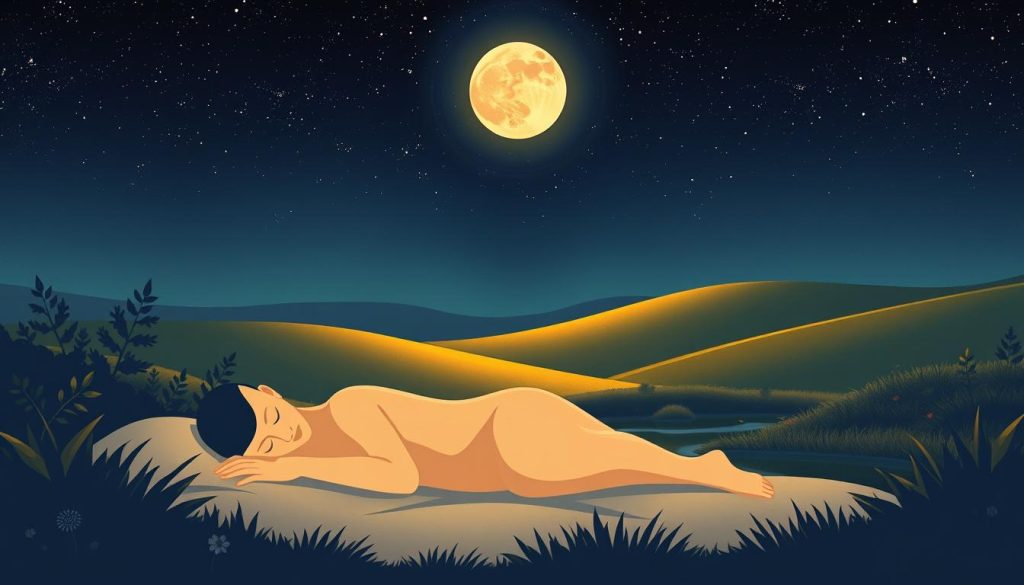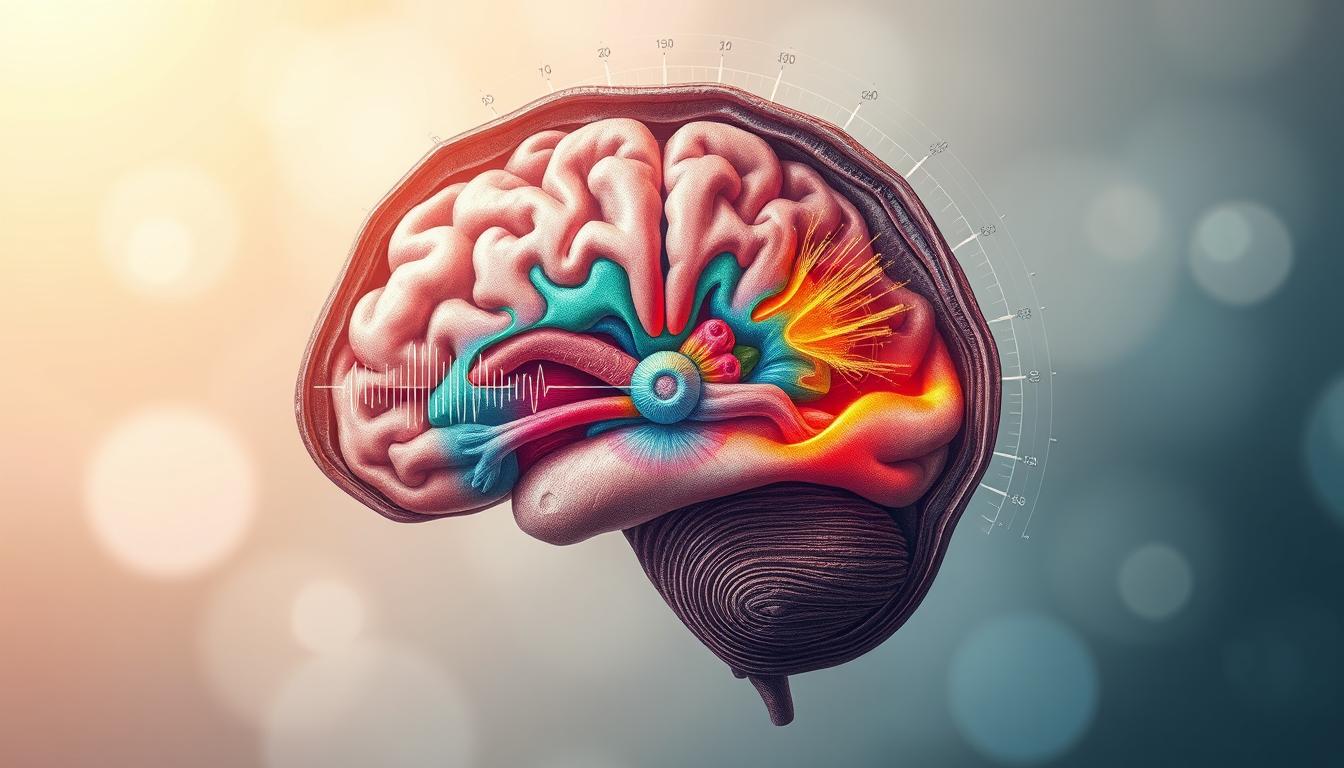Ever felt more awake at some times and tired at others? It’s not just random. Your body has a natural timing system that’s been working for millions of years.
Your biological clock is like a conductor, controlling when you’re alert or sleepy. It affects your body temperature and hormone levels. It’s a fascinating part of human biology.
In today’s world, artificial lights and irregular schedules mess with our natural rhythms. Knowing about circadian rhythm and alertness cycles is key to better daily performance. By understanding your internal clock, you can improve your sleep, work, and lifestyle. This will greatly enhance your life quality.
What is Circadian Rhythm?
Every cell in your body has a 24-hour schedule. This schedule affects more than just sleep. It’s called a circadian rhythm. It helps your body get ready for the day and night.
Knowing about these cycles can change your daily life. Your energy, hormones, and immune system all follow this rhythm.
Definition and Overview
Circadian rhythms repeat every 24 hours. The term “circadian” means “about a day” in Latin. These rhythms are found in all living things, from bacteria to humans.
Chronobiology is the study of these rhythms. It shows that your body’s tiredness and alertness follow patterns. These patterns have evolved over millions of years.
Your sleep-wake cycle is the most obvious rhythm. But these clocks also control body temperature and hormone release. Even your digestion follows a daily schedule.

Biological Importance
These rhythms helped our ancestors survive. They needed to be awake during the day and rest at night. This helped them hunt and gather safely.
Today, chronobiology research shows these rhythms do more than just regulate sleep. They help your body prepare for meals and boost your immune system during rest. This helps your body repair and recover.
When your rhythms work well, you feel awake during the day and tired at night. This timing system improves your physical and mental performance every 24 hours.
Key Components
Your master biological clock is in the brain’s suprachiasmatic nucleus. This area has about 20,000 neurons that keep time. It gets light signals from your eyes and coordinates your body’s timing.
You also have peripheral clocks in organs like the liver and heart. These local clocks help specific functions work with your sleep-wake cycle. They ensure your body systems work together.
Light exposure is key to setting these clocks. Morning light resets your rhythm every day. This keeps your internal timing in sync with the outside world, supporting healthy sleep and alertness during the day.
The Science Behind Alertness Cycles
Our bodies have amazing systems that control when we feel awake and when we need to rest. These systems work all day to match our energy with our activities. Hormones like melatonin and signals from the environment help set our alertness patterns.
Research shows that our alertness cycles are influenced by light, hormones, and brain chemistry. Knowing this helps us understand why we’re more alert at some times and tired at others. It lets us work with our body’s natural rhythms instead of fighting them.
How Light Influences Alertness
Light is key to our alertness. Special cells in our eyes respond to light changes throughout the day. These cells send signals to our brain’s master clock, the suprachiasmatic nucleus.
In the morning, bright light wakes up these cells. This wake-up call boosts our alertness and energy. It helped our ancestors wake up with the sun and stay active during the day. The brain sees bright light as a sign to increase body temperature, heart rate, and focus.

As night falls, our cells detect the dimming light. They start getting ready for sleep. This includes lowering alertness hormones and raising sleep hormones. Artificial light can mess with this natural pattern, making it hard for our body to know when to sleep and wake.
Role of Melatonin and Cortisol
Melatonin, the sleep hormone, starts rising in the evening. It tells our body it’s time to rest and recover. Cortisol, on the other hand, peaks in the morning to help us feel awake and ready to go.
The balance between melatonin and cortisol sets our natural energy rhythm. Melatonin makes us sleepy, while cortisol makes us alert. When this balance is off, we might feel tired when we should be awake or wide awake when we should be sleeping.
Stages of the Sleep-Wake Cycle
Every night, your body goes through different sleep stages. These stages help your mind and body get ready for the next day. Each stage has its own role in keeping you healthy and alert.
There are two main types of sleep each night. These phases work together to help you fully recover. Knowing about these stages shows why getting good sleep is important for how well you do during the day.
Non-REM Sleep Stages
Non-Rapid Eye Movement (NREM) sleep has three stages. Your brain waves slow down a lot in these stages. Each stage helps with physical recovery and memory.
Stage 1 is when you first start to fall asleep. Your muscles relax, and your breathing gets steadier. This stage is very short, lasting just a few minutes.
Stage 2 is the longest part of your sleep. Your heart rate and body temperature go down. Your brain shows special patterns that help you stay asleep.
Stage 3 is the deepest sleep. It’s when your body heals the most. Your immune system gets stronger, and damaged tissues repair best here.
The benefits of NREM sleep include:
- Physical tissue repair and growth
- Memory consolidation from daily experiences
- Immune system strengthening
- Metabolic regulation and hormone balance
- Brain waste removal through cerebrospinal fluid
REM Sleep Phase
Rapid Eye Movement (REM) sleep is the most interesting part of your sleep. Your brain is very active, almost like when you’re awake. This is when you have the most vivid dreams.
REM sleep is important for emotions and creativity. Your brain processes daily experiences and makes new connections. This stage happens more in the morning.
In REM sleep, your body can’t move except for breathing. Your heart rate and blood pressure go up. This keeps you from acting out your dreams.
Key functions of REM sleep include:
- Emotional memory processing and regulation
- Creative problem-solving and insight formation
- Brain development and neural pathway strengthening
- Mood regulation and stress management
- Learning consolidation for complex skills
The sleep-wake cycle repeats every 90 minutes. Early cycles have more deep sleep, and later cycles have more REM sleep. This balance helps your body and mind recover fully.
Impact of Circadian Rhythms on Daily Life
Your body’s natural timing system affects your mood, energy, and productivity. It doesn’t just control when you sleep and wake. It also influences your focus, stress levels, and more.
The link between your biological clock and daily performance is deep. Your circadian system works with your body to create patterns of alertness and energy. These patterns happen every 24 hours.
Effects on Mood and Productivity
Your chronotype determines when you feel most alert and capable. Morning larks do best from 8 AM to noon. Night owls, on the other hand, shine in the evening.
Body temperature changes show your natural energy cycles. When your core temperature rises, you’re more alert. When it drops, you’re ready to rest. These changes affect your focus and problem-solving skills.
Working against your natural chronotype can cut productivity by up to 25%. Aligning tasks with your prime time boosts focus and results. Creative work flows better during peak hours, while routine tasks are better done when you’re less energetic.

Your mood also follows a natural pattern. Most people feel low in the early afternoon and late evening. Knowing this helps you plan your day better and avoid tough conversations during these times.
Connection to Sleep Disorders
Disrupted circadian rhythms often cause sleep disorders. Insomnia happens when your internal clock and sleep schedule don’t match. This makes it hard to sleep when you want to.
Delayed sleep phase syndrome affects those who naturally go to bed and wake up later. It’s more than just being a night owl. It can affect work and social life. This condition often starts in the teenage years when circadian rhythms naturally shift later.
Seasonal affective disorder shows how light affects your circadian rhythms and mental health. Less daylight in winter can mess with your body temperature and melatonin. This can lead to depression, fatigue, and changes in appetite.
Many sleep problems come from disrupted circadian rhythms, not just bad sleep habits. Fixing the timing issues is often more effective than trying to sleep at conventional hours. Knowing your natural patterns helps improve sleep and daily life.
Tips for Optimizing Your Circadian Rhythm
Making small changes to your daily routine can greatly improve your sleep. Your body’s internal clock responds well to consistent signals and gentle changes. It’s important to work with your natural rhythms, not against them.
Modern life often messes with our natural patterns. But, you don’t need to change everything. Small, lasting changes can improve your sleep and energy during the day. Let’s look at some easy tips that fit into your busy life.

Establishing a Consistent Sleep Schedule
Your sleep schedule is key to healthy circadian rhythms. It’s more important to be consistent than perfect. Even small improvements can make a big difference over time.
Start by picking bedtime and wake-up times that you can stick to most days. Slow changes are better than big ones. For example, if you want to sleep at 10 PM but now go to bed at midnight, try going to bed 15-30 minutes earlier each night.
Keeping your sleep schedule the same on weekends helps keep your progress all week. Try to stay within one hour of your weekday routine. This avoids the “social jet lag” that messes with your rhythm.
Here are some practical steps for consistency:
- Set a gentle alarm for bedtime preparation, not just wake-up time
- Create a 30-minute wind-down routine before sleep
- Use your natural chronotype as a guide rather than forcing unnatural patterns
- Allow flexibility for special occasions while returning to routine quickly
Managing Light Exposure
Light is the most powerful signal for your circadian system. Using light wisely can reset and strengthen your internal clock. Knowing when and how to use light makes it easier to optimize.
Morning light exposure within the first hour of waking helps set your circadian anchor. Natural sunlight is best, but bright artificial light works on cloudy days. Even 10-15 minutes of morning brightness can help.
Evening light management is also crucial for good sleep. Dim your environment 2-3 hours before bedtime to signal sleep time. This doesn’t mean complete darkness, but softer, warmer lighting.
Here are effective light management strategies:
- Open curtains immediately upon waking to catch natural light
- Take a brief morning walk or sit by a bright window
- Use blue light filters on devices after sunset
- Install dimmer switches or use lamps instead of overhead lights in the evening
- Consider blackout curtains or eye masks for complete darkness during sleep
Screen time before bed needs special care since devices emit blue light that can lower melatonin. If you must use screens in the evening, enable night mode or use blue light blocking glasses. Better yet, have a screen curfew one hour before sleep.
Remember, these signals work best when used consistently. Your circadian system thrives on predictable patterns. So, be patient and persistent for better sleep and more energy during the day.
Circadian Rhythm Disruptions
Modern life makes it hard to keep a healthy sleep-wake cycle. Your body’s internal clock can get thrown off by daily activities and lifestyle choices. Knowing what disrupts your sleep helps you improve it.
Common Causes
Shift work is a big disruptor of natural sleep patterns. Working at night makes your body stay awake when it wants to sleep. Traveling across time zones also causes problems.
Screen time before bed messes with melatonin production. The blue light from phones and computers tricks your brain into thinking it’s still day. Irregular sleep on weekends can also mess with your internal timing.
Caffeine late in the day blocks sleep signals. Stress and anxiety make it hard for your body to keep its natural rhythm. A poor bedroom environment with too much light or noise adds to the challenge.
Strategies for Improvement
Start by setting a consistent sleep schedule, even on weekends. Go to bed and wake up at the same times every day. This helps your internal clock adjust slowly.
Limit screen time two hours before bed. Use dim red lights in the evening instead of bright white ones. Get morning sunlight within an hour of waking up.
Make your bedroom dark, cool, and quiet. Consider blackout curtains and white noise machines. Avoid caffeine after 2 PM and big meals close to bedtime.

